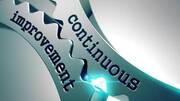Upgrade & Secure Your Future with DevOps, SRE, DevSecOps, MLOps!
We spend hours on Instagram and YouTube and waste money on coffee and fast food, but won’t spend 30 minutes a day learning skills to boost our careers.
Master in DevOps, SRE, DevSecOps & MLOps!
Learn from Guru Rajesh Kumar and double your salary in just one year.
Source:-customerthink.com
In my last article, I introduced a business strategy that Gartner calls ContinuousNEXT – an evolution of what we often call ‘digital transformation’ today into a business that is constantly able to adapt and change. I’d like to continue on this theme for a few more articles and in this one, I will focus on culture.
The main difference between a focus on continuous improvement and a traditional digital transformation strategy is that the continuous approach embraces reality. Your business is constantly changing because the customers, competition, and business environment are also changing. If you can build a culture of change deep into your business, rather than relying on unreliable digital transformation programs, then you are better placed to succeed.
This is the keyword – culture. As the legendary management advisor Peter Drucker once said: “culture eats strategy for breakfast!” You can build strategies and plans that aim to incorporate change in your business through well-designed road-maps into the future, but if you don’t care for the culture of the business then your plans are unlikely to succeed. The reality of corporate change is that strategy, capabilities, and culture are all connected and equally important.
In a company that embraces the idea of ContinuousNEXT, every employee in the organization would embrace the idea of continuous improvement and feel enabled to make suggestions and create change. This applies regardless of which type of continuous improvement you adopt. Six Sigma, Lean, Kaizen, and the Toyota Way are all established methods, but the benefits are universal.
On the technical side of the business, this means the adoption of continuous improvement policies such as continuous development, continuous deployment, continuous integration, continuous quality, continuous data protection, and continuous backup. The key cultural point is that your backup policy or data protection policy can always be improved. Nothing is set in stone and defined. Everyone is enabled to improve procedures and should actively be engaged in continuously improving the procedures used by the company.
This can also apply to other areas of the business, such as how people are managed. Your human resources team can use continuous performance management to continually monitor how the team is performing and to make improvements continuously, not just at a once-per-year review.
Some individual sections of your business may already be used to this type of continuous improvement. Software developers today are generally familiar with the Agile development model, rather than the more traditional Waterfall model. They are easy to contrast – the waterfall approach requires that you proceed step-by-step along a defined process. Define a problem, design a solution, code it, test it, go back to the start until the problem is resolved. In comparison, an Agile approach ensures that developers make small changes frequently so it’s easy to back out when a change doesn’t work, but the system is continuously improving.
Creating a continuous improvement culture across your entire organization is in itself an enormous change management project, but one that can yield immediate process improvements and long-term benefits in quality and efficiency, but also in the wider employee experience.
If your employees are able to influence continuous improvement then that is empowering for them. Their experience of working for your organization is improved and their performance will almost certainly improve. Creating a culture of continuous improvement engages people, which is great for them individually, but even better for the wider organization because your business is always improving.

 Starting: 1st of Every Month
Starting: 1st of Every Month  +91 8409492687 |
+91 8409492687 |  Contact@DevOpsSchool.com
Contact@DevOpsSchool.com